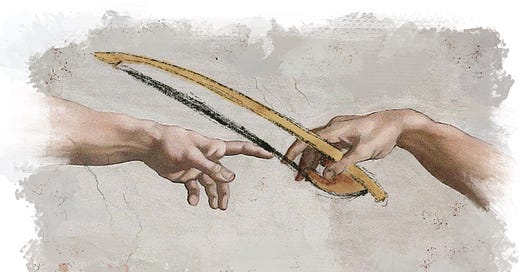We saw this almost by chance, four year ago during a free day in Rome. It’s so close to those other two below that we got enthusiastic at once!
The official version in music history is that in Italy, in the mid of the 17th century, wound strings were invented. This allowed basses to be shorter. In other words, this led to the birth of the violoncello, the short violone.
When I see these three images together, I cannot help questioning whether this was really only an Italian movement or if it was happening on a larger scale. Or, maybe, pre-existing tenor instruments were now possibly tuned as basses, thanks to the new strings.
This stucco is in Palazzo Barberini and was made in 1630. Quite a place and a time to be!
Palazzo Barberini was commissioned by Maffeo Barberini, who later became pope with the name Urbano VIII. The two major artists working here, as well as the two favourites by Maffeo Barberini, were Gian Lorenzo Bernini and Pietro da Cortona.
Maffeo Barberini was not someone who passively accepted what the culture of the time offered him. Instead, he shaped the official culture. At the age of 30 he had himself portrayed by Caravaggio, he commissioned everything Bernini made in the Vatican, the triton fountain, he took an active part in the 30 years' war and also in the trial of Galileo Galilei. Palazzo Barberini included a big theatre where operas were displayed. The presence of this instrument in his home makes it a part of official culture. No longer Bruegel's bassetto in peasant’s hands, but the history of official cultured music of the seventeenth century.
Isn’t 1630 too early to speak about violoncello?
Nope, not at all: the fact that wound strings were first mentioned in the second half of that century (Peruffo) doesn’t mean they were unavailable a few decades before. It is not like today, where something is published (and sold) before it exists. It took decades for a technological novelty to become printed words. And we may not have found the eldest source yet.
What we know, for example, is that violoncino and violonzono are mentioned in the sonatas by Giovanni Battista Fontana, published posthumously in 1641 (Badiarov). G. B. Fontana also worked in Rome and died in Padua during the 1630 plague.
Further readings:
Mimmo Peruffo on the first mention of wound strings
Dmitry Badiarov, notes for a lecture at Utrecht Conservatory, 2012
Curiosity: where does the Barberini coat of arms come from? Originally it was not three bees but three horseflies, as the family name was Tafani, literally horsefly. All this was not aristocratic enough, so they changed their name to Barberini (from the name of Barberino Val d’Elsa, the village the family came from, close to Florence) and the horseflies in bees.
This is our newsletter number 100! Thanks for reading us! Are you curious to see what happened before?
Featured video of the week
Pre-concert interview: looking forward to the concert video!











